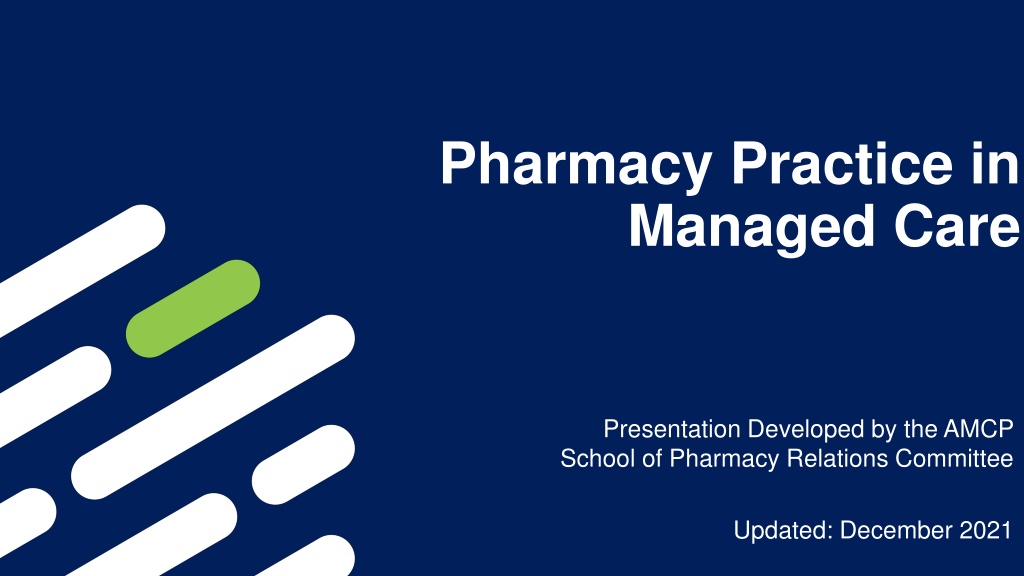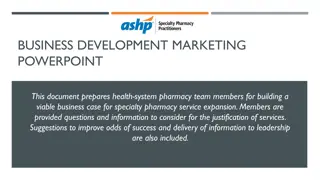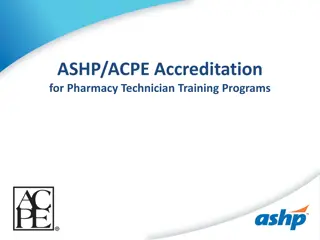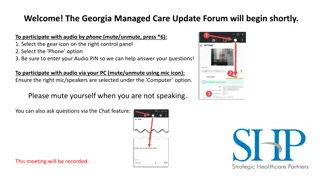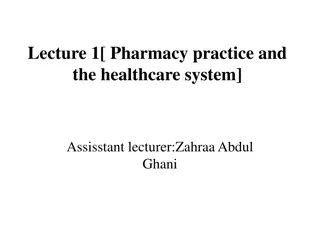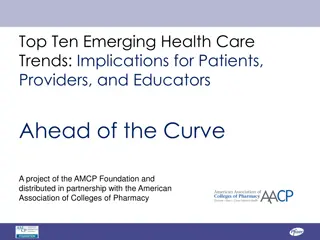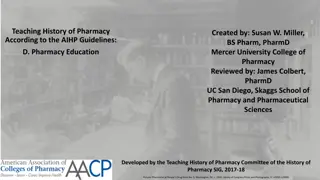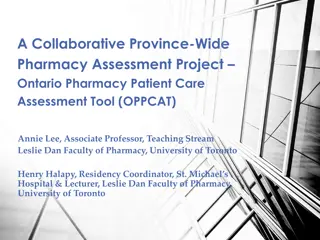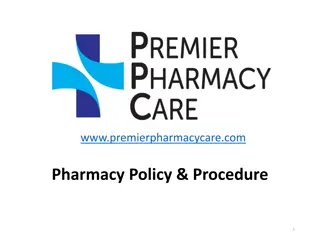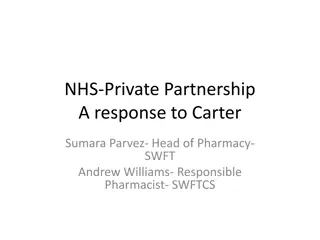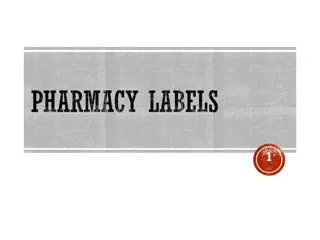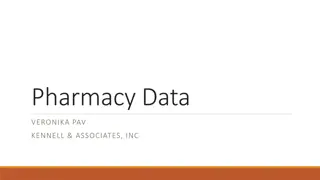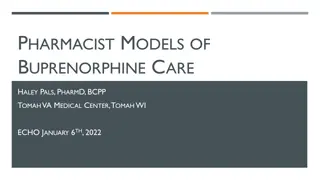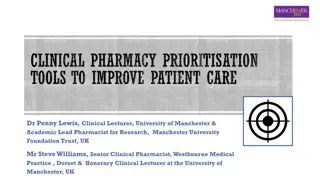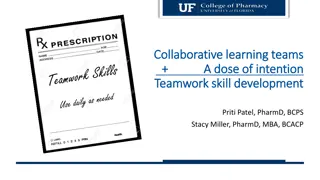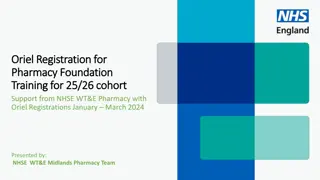Understanding Pharmacy Practice in Managed Care: A Comprehensive Overview
Delve into the world of managed care pharmacy practice with insights on its definition, evolution, participants, goals, types of organizations, cost containment strategies, and benefit design considerations. Discover how managed care aims to improve healthcare quality, accessibility, outcomes, and cost efficiency through various mechanisms like formulary management and utilization controls.
Download Presentation

Please find below an Image/Link to download the presentation.
The content on the website is provided AS IS for your information and personal use only. It may not be sold, licensed, or shared on other websites without obtaining consent from the author. Download presentation by click this link. If you encounter any issues during the download, it is possible that the publisher has removed the file from their server.
E N D
Presentation Transcript
Pharmacy Practice in Managed Care Presentation Developed by the AMCP School of Pharmacy Relations Committee Updated: December 2021
Managed Care Definition An organized health care delivery system designed to improve both the quality and the accessibility of health care, while containing costs Evolution Historical factors Economic factors Technological factors Social factors Government factors
Participants in Managed Care Members Healthcare Professionals prescribers, pharmacists, nurses, etc. Pharmacies Plan sponsors health plans, employers, government organizations, etc. Pharmacy benefit managers (PBM) Disease State Management Entities Consultants
Goals of Managed Care Prevention of disease Focus on wellness and improved quality of life for patients Improved outcomes Improved quality and accessibility of health care and drug therapy Control and contain costs
Types of Managed Care Organizations Health Maintenance Organization (HMO) independent practice association, staff, group, network Preferred Provider Organization (PPO) Exclusive Provider Organization (EPO) Point of Service (POS) hybrid PPO and HMO
Cost Containment Strategies Benefit Design Cost share Formulary management Mandatory generic and mail programs Utilization management Communication Networks Pricing Free Preventative Care
Benefit Design Cost Share Co-pay: fixed charge, paid by member for each medication purchased Co-insurance: an established percentage of the allowed drug cost that is the member s responsibility Tiers: cost share varies based on type of drug. oExamples: two tiers: generic/brand co-pays three tiers: generic/preferred brand/non-preferred brand co-pays Formulary list of approved medications that encourages use of safe, efficacious, cost-effective agents Open: most medications covered, different cost share may be assigned (preferred vs. non-preferred) Closed: certain medications or classes excluded from coverage
Benefit Design Mandatory generics program where generic drug must be dispensed in order for payment Mandatory mail program that requires maintenance medications to be filled through mail order pharmacy greater plan discount with mail order financial incentive to member to use mail order
Benefit Design Utilization Management Prior authorization Step-therapy Quantity limits Generic Substitution Therapeutic drug equivalent Therapeutic biologic drug (biosimilar) equivalent
Education Strategies Patients Consultation, benefits of generics, etc. Physicians Detailing and profiling Pharmacies Health Plan Drug information Support of clinical programs Newsletters and educational materials Pharmaceutical Representatives
Pharmacy Network Definition: A contracted group of pharmacies that provide incentivized rates to a managed care organization, lowering costs for MCOs and patients. Pharmacy contract with managed care organization Receive lower reimbursement rates o e.g.. (AWP - 12%) + dispensing fee Increased volume of business
Pharmacy Network Networks are determined by payer requirements Access: Distance a member must travel to reach a network pharmacy (5 miles, 10 miles, etc.) Density: Number of pharmacies available to a member within the access requirement
Retail Pharmacy Chains and independents Services in close proximity to members Prescription quantities 30 or 90 day supply may be obtained at retail pharmacies depending on health plan benefit design. Networks can be: Open - All pharmacies within a geographical area Closed - Drug benefit is available only at designated pharmacies Preferred - Pharmacy tiers (e.g. 1st tier pharmacy = lowest cost); subsequent tiers have a higher cost for members
Mail Service Pharmacy Convenient and private Larger quantity and lower cost for customer e.g. 90-day supply for less than 3 retail copays Useful for chronic medications Education and counseling is conducted via telephone Drawbacks lag time in receiving prescription, potential for stock-piling or drug wastage
Integrated Pharmacy Networks Most popular form includes community pharmacies combined with mail order Community pharmacies offer access to acute medications Community pharmacies are needed for initiation of maintenance medications until patients become stable on a dosage regimen Mail-service pharmacies are needed to realize maximum savings on maintenance medications so that consumers drug costs are reduced
Pricing Terms Average Wholesale Price (AWP): a published reference price for drugs that is becoming outdated in favor of alternative pricing structures such as Average Sales Price (ASP) Previously, AWP was often used as a basis for payment to retail pharmacies by public and private third-party payers Usually contracted in the form of: (AWP - %) + dispensing fee Ingredient Cost: drug cost used for claims processing; includes discounts at retail and mail service and other plan-specific pricing rules Maximum Allowable Cost (MAC): list of certain generic and multi-source brand products where maximum price is set for reimbursement to pharmacy (cost per tablet/capsule)
Pricing Terms Usual and Customary (U&C) price: price a cash-paying customer would pay for a prescription Wholesale Acquisition Price (WAC): price that pharmaceutical manufacturers set for their medication prior to any discounts or rebates that a wholesaler or distributor would pay National Average Drug Acquisition Cost (NADAC): prices that retail pharmacies pay to purchase drug products CMS published benchmark created through a national survey of actual invoice prices paid by retail pharmacies to wholesalers
Fee Arrangements Capitation (PMPM) Discounted fee-for-service Salary Withholds The goal is to reward providers who deliver quality, cost-effective care and discourage excessive utilization of medical services.
Pharmacy Benefit Management Pharmacy service functions (and other specialty services) can be completed by an outside vendor or entirely carved out because: Pharmacy is an easily defined benefit Pharmacy has a defined patient population High or rising costs Inappropriate utilization By 1998, 88.4% of HMOs contracted with PBMs. Also manage benefits for self-insured employers, MCOs, and government.
Pharmacy Benefit Managers (PBMs) History: began in early 1990 s May be owned by insurance company, HMO, manufacturer, retail pharmacy, or private Work with clients to manage drug trend and spend Use volume-purchasing power to gain discounts from manufacturers More than a claims processor
Key PBM Activities Benefit Design Claims Processing Formulary Management Rebate Contracting Drug Utilization Review Pharmacy Network Contracting Network Maintenance Customer Service Mail/Specialty pharmacy Utilization management PBM can provide all or selected functions decided by the plan sponsor
Selected Pharmacy Benefit Managers CVSCaremark_Caremark
Rebate Contracting & Trade Relations Pharmaceutical Rebate: A contracted percentage of the total drug cost that a MCO can receive from a pharmaceutical manufacturer in return for certain utilization metrics Rebate Percentage for a drug may be determined by: How many drugs are currently in the therapy class How many generics are available in the therapy class Life-Cycle Management: How long before the medication goes generic Type of medication: Oral, injectable, specialty, etc.
Quality Assurance Measuring Structure Process Outcome Accreditation NCQA: National Committee for Quality Assurance TJC: The Joint Commission (formerly JCAHO) URAC: Utilization Review Accreditation Commission Performance Measures STAR Ratings, FACCT, HEDIS, ORYX, Quality Compass, AHRQ, HCFA
STAR Ratings A set of Medicare quality measures that affects reimbursement to health plans that began in 2012 Star Ratings are made public and may impact patients choices on their individual health plans Reimbursement percentage is significant and may affect how MCOs manage patient care Examples include: Percent of diabetics on an ACE/ARB Percent of members with hyperlipidemia who are on a statin Member complaints about health plan
Strategies & Tools for Quality Improvement Benchmarking Clinical practice guidelines Provider profiling Peer review Patient risk modeling and analysis Assures a minimum acceptable level of care is obtained for patients by payers Attracts and retains better professionals.
Outcomes Based Research How does the drug work in the real world ? May be generated by health plans, health care facilities, pharmaceutical companies, etc. Measure real world efficacy (e.g., cure rates), safety (rates/severity of AE s), impacts to quality of life such as activities of daily living (ADLs), rate of hospital admissions or other healthcare resource utilization, etc. Results of outcomes research has also alerted the public of several safety concerns in the recent past
Legal Aspects of Managed Care Federal Legislation General Business Legislation Antitrust laws Employee Benefit o Retirement Income Security Act of 1974 (ERISA) Ensures that employer- sponsored benefit plans are uniformly developed and administered. MCOs are generally protected from liability for their administration of pharmacy benefits. o Consolidated Omnibus Budget Reconciliation Act of 1986 (COBRA) Continuation of employees group health coverage after a qualifying event
Federal Healthcare Legislation HMO Act of 1973 Health Insurance Portability and Accountability Act (HIPAA) of 1996 Increase the continuity of coverage when individuals change employment Standards to facilitate data exchange among entities that finance and deliver healthcare services Claims and eligibility inquiries Privacy and security of individually identifiable health information Patient s Bill of Rights Medicare Prescription Drug, Improvement and Modernization Act (MMA) of 2003 Patient Protection and Affordable Care Act (PPACA)
State Laws National Association of Insurance Commissioners (NAIC) HMO Model Act regulates financial responsibility and healthcare delivery Preferred Provider Arrangements Utilization Review laws Health Plan Accountability laws Health care professional credentialing verification Quality assessment and improvement Network adequacy and accessibility Grievance procedures Privacy of financial and healthcare information Any Willing Provider laws must allow any pharmacy to provide service if they accept the terms of the contract Narrow Therapeutic Index bills prohibit generic substitution of some drugs
Future of Distribution Systems Continued use of network pharmacies Increased use of integrated systems Integration of pharmacy data with medical data (hospital, physician, laboratory) at the point-of-service (POS) level for improved outcomes
Controversies Surrounding Managed Care Who should make the decision of allocation of resources (government, employers, insurers, physicians, consumers)? Does a formulary trade cost for quality? Are disease management programs cost-effective? Do savings from prior authorization offset the costs of administration? Should pharmacists be reimbursed for cognitive services? Transparency around PBM rebates; Sick patients generating rebates that the rest of the members benefit from
Prepping for a Career in Managed Care Knowledge, decision making, and critical thinking abilities Communication abilities Leadership abilities Lifelong learning abilities General business management abilities Managed Care offers a unique mix of business and clinical opportunities!
Hands On Experience Internships Externships Residencies listed on AMCP and ASHP s websites Fellowships specializing in managed care Student membership in AMCP
Networking Attending the Fall and Spring AMCP meetings offers valuable opportunities to network with the leaders of Managed Care Pharmacy National Meetings offer Student Programming that is very beneficial for personal development Attend local AMCP Affiliate meetings to meet influential people in your region!
References Robert P. Navarro. Managed Care Pharmacy Practice. 2nd ed. Sudbury, MA. Jones and Bartlett Publishers. 2009. Thomas S. Bodenheimer and Kevin Grumbach. Understanding Health Policy, McGraw Hill, 2002
Mission & Vision To improve patient health by ensuring access to high-quality, cost-effective medications and other therapies.
Thank you to AMCP member Thomas Walters for updating this presentation
